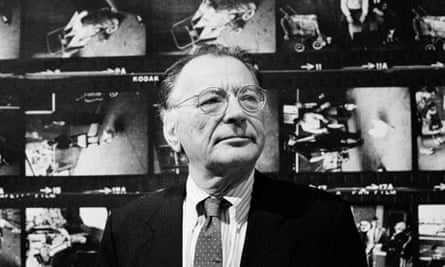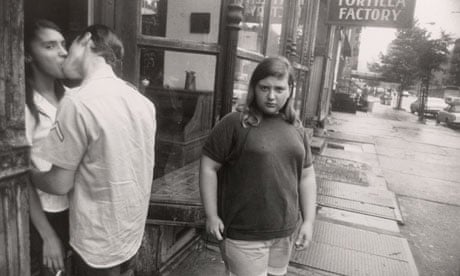It's three years to the month since John Szarkowski died: a good time to reappraise his role as a defining figure in photography, both in establishing it as an art form and in influencing the public's perception. Szarkowski was a good photographer, a great critic and an extraordinary curator. One could argue that he was the single most important force in American post-war photography.
Like all good critics and curators, Szarkowski was both visionary and catalyst. When he succeeded the esteemed photographer Edward Steichen as director of the Museum of Modern Art in New York in 1962, he was just 36, and must have been acutely aware of the long shadow cast by his predecessor. Steichen had curated the monumental group exhibition, The Family of Man, at Moma in 1955, which he described as 'the culmination of his career". Featuring 503 images by 273 photographers, famous and unknown, it had aimed to show the universality of human experience: death, love, childhood. The show had drawn huge crowds to the gallery and then toured the world, attracting an estimated 9 million viewers.
It was, as Steichen had no doubt intended, a hard act to follow. "We were different people", Szarkowski later said, "with different talents, characters, limitations, histories, problems and axes to grind. We held the same job at very different times, which means that it was not really the same job."
More revealingly, Szarkowski also said that Steichen and his predecessor, Beaumont Newhall, "consciously or otherwise, felt more compelled than I to be advocates for photography, whereas I – largely because of their work – could assume a more analytic, less apostolic attitude." That difference in approach would prove to be a crucial one, and it underpinned a new photographic aesthetic that continues to shape our view of the world to this day.
When Szarkowski took over at Moma, there was not a single commercial gallery exhibiting photography in New York and, despite Steichen and Newhall's pioneering work, the form had still not been accepted by most curators or critics. Szarkowski changed all that. He was the right person in the right place at the right time: a forward thinker who was given control of a major art institution at a moment when his democratic vision chimed with the rapidly changing cultural tastes of the time.

Szarkowski insisted on the democracy of the image, whether it be a formally composed Ansel Adams landscape, a snatched shot that caught the frenetic cut-and-thrust of a modern city or a vernacular subject like a road sign or a parking lot. "A skillful photographer can photograph anything well," he once insisted.
In his still-challenging book, The Photographer's Eye (1964), Szarkowski included snapshots alongside images by great photographers, and argued – brilliantly – that photography differed from any other art form because its history had been "less a journey than a growth". "Its movement has not been linear and consecutive but centrifugal," he suggested. "Photography, and our understanding of it, has spread from a centre; it has, by infusion, penetrated our consciousness. Like an organism, photography was born whole. It is in our progressive discovery of it that its history lies."
As a writer, Szarkowski was innovative; as a curator, he was revolutionary. In 1967, during the so-called Summer of Love, he curated a show called New Documents at Moma. It featured the work of three relatively unknown photographers: Diane Arbus, Lee Friedlander and Garry Winogrand, and was, in its visceral way, as out of step with the times as the urban, edgy, atonal music of the Velvet Underground. It caused a stir. Arbus's images were transgressive in both their form and content: harsh black and white shots of so-called freaks, outsiders and misfits. Friedlander and Winogrand, in their different ways, shot on the streets of New York, producing snatched images of the city's everyday momentum that often appeared to be casual, even random – documentary photography, but not as it was then known or understood.
In his introduction to New Documents, Szarkowski deftly defined the shift in emphasis that the work represented and the attitude that unified the three photographers. "In the past decade," he wrote, "a new generation of photographers has directed the documentary approach toward more personal ends. Their aim has been not to reform life, but to know it."
At Moma, Szarkowski also hosted challenging shows by pioneering European photographers like Lartigue, Brassai and Cartier-Bresson, and, in 1969, purchased most of Eugene Atget's archive for the museum. The Lartigue show, which consisted of photographs he had taken as a child, was controversial and critically lambasted. The controversy was low-key, though, compared to the tidal wave of outrage that greeted Szarkowski's showing of the work of a then-unknown photographer from Tennessee called William Eggelston, in 1976.
Entitled William Eggleston's Guide, it was the first show of colour photography at Moma, a decision that incensed the critics almost as much as the supposedly banal and vulgar subject matter. When I once asked Eggleston about the reaction to the show, he said, It didn't surprise or offend me. Didn't impinge on me at all". The loudest critical voice belonged to Hilton Kramer of the New York Times, who famously wrote: "Mr. Szarkowski throws all caution to the winds and speaks of Mr. Eggleston's pictures as 'perfect'. Perfect? Perfectly banal, perhaps. Perfectly boring, certainly."
As time has shown, Kramer was wrong and Szarkowski – not for the first time – was right. His introduction to the book of the exhibition remains one of the great pieces of writing on modern photography. In retrospect, though, Szarkowski's greatest gift was not his brilliant critical mind, nor his ability to help define what is now accepted as a canon of great photography, but his willingness to take risks with his own reputation. By the time he died, on 7 July 2007, aged 81, Szarkowski had returned to his first love, the taking of photographs. He was described by an obituary writer as "the man who taught America how to look at photographs." It still does not seem too extravagant a claim.
Now see this
Nazraeli Press specialises in producing beautiful limited edition art photography books. Retrados Pintado is no exception. The book collects images of hand-painted portraits of the dead that appear on the walls of houses throughout north-east Brazil. Here, recently expired relatives take on the appearance of contemporary saints. Collected by Titus Reidl and edited by Martin Parr, the book is available from Amazon and selected photography book shops. At £40, it's costly, but beautiful.

Comments (…)
Sign in or create your Guardian account to join the discussion